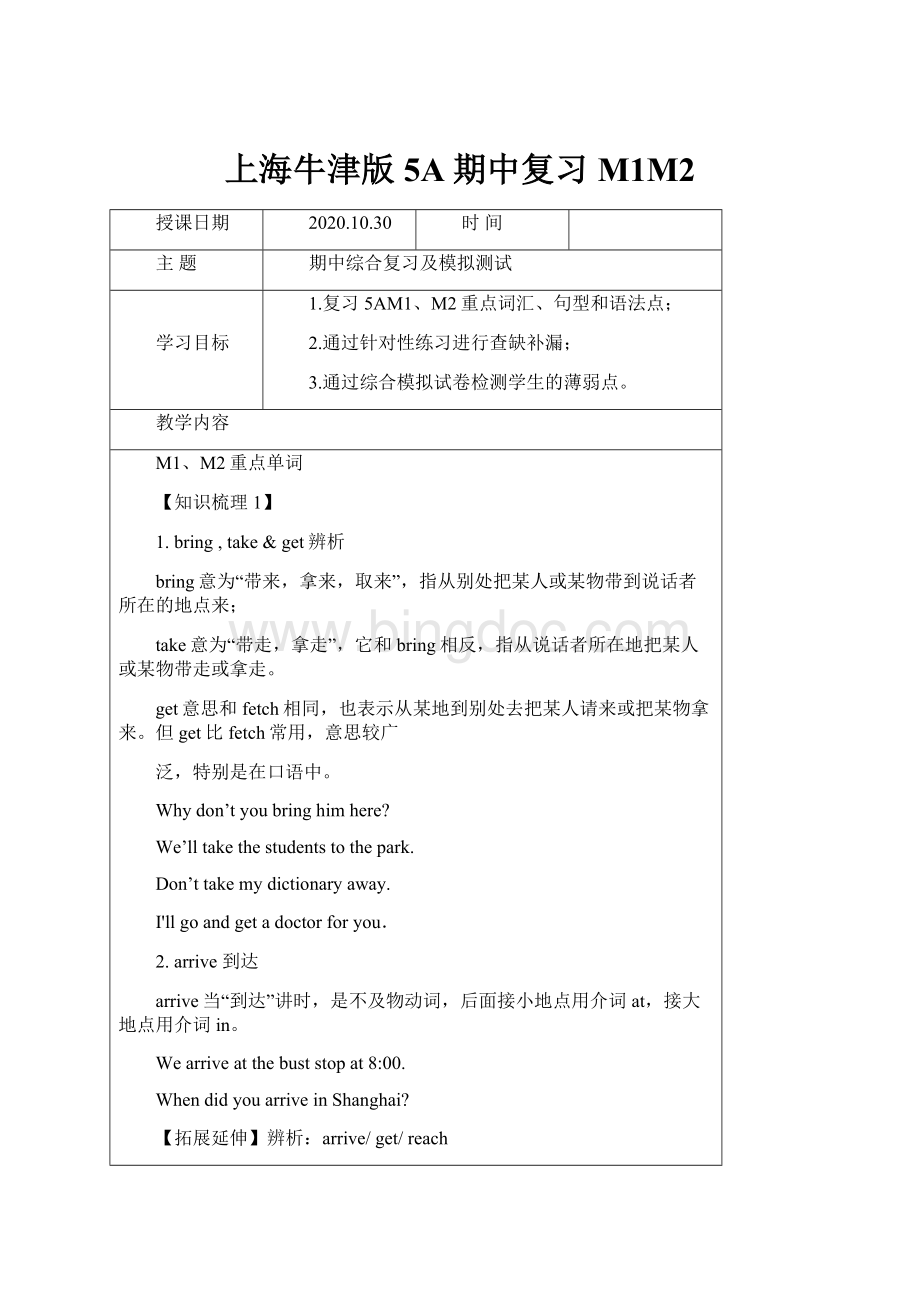上海牛津版5A期中复习M1M2Word文档下载推荐.docx
《上海牛津版5A期中复习M1M2Word文档下载推荐.docx》由会员分享,可在线阅读,更多相关《上海牛津版5A期中复习M1M2Word文档下载推荐.docx(22页珍藏版)》请在冰点文库上搜索。

(3)reach当“到达”讲时是及物动词,后面直接接地点名词,不需要任何介词。
Thestudentsgettoschoolat7:
30everyday.
TomandIreachedShanghailastweek.
3.cross横穿
cross作动词,意为“横穿”,如:
crosstheroad,crossthebridge等;
Becarefulwhencrossingthestreet!
cross;
across;
through;
(1)cross动词,意为“横穿”,直接接宾语;
(2)across介词,“穿过”,常和动词连用,指从表面穿过,如walkacrossthestreet;
;
(3)through介词,“穿过”,常和动词连用,指从立体空间内部穿过,如walkthroughtheforest;
[例句]Xiaomeiishelpingagrandmagoacrosstheroad.小梅正在帮一位老奶奶过马路。
Thetwofriendsgothroughtheforesttogether.两个朋友一起穿过森林。
【例题精讲】用cross,across和through填空
1.Theylive______theCentralPark.
2.Everyoneshouts“killit!
”whenaratisseentorun______thestreet.
3.Theyhave______overtoJapan.
4.Allcarsshouldstopatthezebra_______.
5.Wewalked______theforest.
Key:
across;
crossed;
crossing;
through
【巩固练习】用所学单词填空
1.Shewalks_______theroad.
2.Nexttimedon'
tforgetto_______meacopyofyourwork.
3.Thepoliceledtheoldman________thestreet.
4._______theboxaway,please.
5.Thestreamwinds_________thevillage.
6.Itrytogetintotheroom________thewindowbecauseIcan’topenthedoor.
7.Whendidyouarrive_______thevillage?
8.We
must
________
the
road
very
carefully.
9.Iusually______homeatabout5o'
clockintheafternoon.
10.WhendidJim______subwaystation?
1.across2.bring3.across4.take5.through6.through7.in8.cross9.get10.reach
【知识梳理2】
4.enoughadj.足够的可以修饰名词或形容词、副词。
修饰名词时放在名词前面;
修饰形容词副词时放在后面。
Heisoldenoughtogotoschool.
Ihaveenoughtimetogettoschool.
5.alotof=lotsof大量的;
许多;
既可修饰可数名词,也可修饰不可数名词;
【拓展延伸】
只能修饰可数名词:
many;
(a)few;
alargenumberof;
只能修饰不可数名词:
much;
(a)little;
ahugeamountof;
agreatdealof;
既可修饰可数名词,也可修饰不可数名词:
some;
any;
alotof;
lotsof;
plentyof;
6.【★表示花费时间的两个句型★】
(1)Ittakessb.sometimetodosth.
(2)Sb.spendssometimeonsth/(in)doingsth.
【★表示花费金钱的三个句型★】
(1)Itcostssb.somemoneytodosth./sth.costsb.Somemoney
(2)Sb.spendssomemoneyonsth/(in)doingsth.
(3)Sb.Paysomemoneyforsth.
Ispenttenyuanonthebook.
Ipaidtenyuanforthebook.
Thebookcostmetenyuan.
【例题精讲】
例1.Heranandran,buthecouldn’trun_____tocatchthebus.
A.FastenoughB.enoughquickC.enoughfastD.enoughquickly
例2.Mikeisonly15yearsold.Heisnot______togetadriver’slicense.
A.oldenoughB.enougholdC.youngenoughD.enoughyoung
Keys:
AA
【巩固练习】给下列句子填上合适的单词。
1)Ittakes_____threehours_________thehouseworkeveryday.
2)Ihave________homeworktodoeveryday.
3)Ispendhalfanhour_____mymathshomeworkeveryevening.
4)She_______halfanhour__________breakfasteverymorning.
5)Ihaveto_____them1000yuan_____thisroomeverymonth.
6)Afterchoosingtheproduct,youhaveto_________it.Thenyoucanreceiveitbypost.
7)Thiscoat______me500yuan.
8)I____800dollars________English.
me,todo;
lotsof/plentyof;
on;
spends,oneating;
pay,for;
payfor;
costs;
spend,inlearning.
M1、M2重点语法
【知识梳理1】数词
表示数量或顺序的词叫做数词。
数词分为两大类,即基数词和序数词。
基数词表示数量,如:
one,two,three,four……;
序数词表示顺序,如:
first,second,third,fourth……,序数词前一般要加the
一、【基数词的构成】
(1)1~12是独立的数词.即one,two,three,four,five,six,seven,eight,nine,ten,eleven,twelve.
(2)13~19在3~9词尾加后缀-teen,注意13,15,18的拼写形式.thirteen;
fifteen;
eighteen;
(3)20~90八个整十位数在词尾加后缀-ty,注意20,30,40,50和80的拼法.twenty;
thirty;
forty;
fifty;
eighty;
(4)21~99由十位数和个位数合起来构成的两位数词,需在中间加连字符"
-"
.twenty-one;
thirty-two;
(5)101~999的三位数,在十位数与百位数之间加and;
若有个位数,且十位数为零,则在个位数与百位数之间加and.230(twohundredandthirty);
101(onehundredandone);
二、【序数词的构成】
(1)从第一至第十二:
________________________________________________________________(默写)
大多的序数词都是由其相对应的基数词后面添加“th”构成。
(2)从第二十至第九十九整数第几十的形式由其对应的基数词改变结尾字母y为ie,再加“th”构成.
第二十___________________;
第四十_____________________;
第五十_____________________;
第八十___________________;
第九十_____________________;
(3)表示第几十几时,用几十的基数词形式加上连字符“-”和个位序数词形式一起表示。
第三十一_________________;
第五十六___________________;
第九十九___________________;
(4)序数词的缩写
first–1st,second–2nd,third–3rd;
fourth–4th,sixth–6th;
twentieth–20th;
twenty-third-23rd
其中1st,2nd,3rd为特殊形式,其它的都是阿拉伯数字后加上th.
小游戏:
接龙说数:
接龙说数是师生或学生轮流说出英语数词的游戏。
具体做法是:
师生或学生轮流按顺序说出英语数词(可以包括基数词和序数词)。
例如:
T:
One.S1:
Two.T:
Three.S2:
Four.…依此类推,或者说序数词,T:
first.S1:
second.T:
Third.S2:
Fourth.…。
教师也可以要求学生按逆序说出自己说的英语数词前一个数。
Five.S3:
Four.
接龙说数能帮助学生熟悉英语数词及基数词和序数词的区别。
例1.Whatwouldyoulike,sir?
—______.
A.TwopopB.Twobottleswater
C.TwobottlesofwaterD.Twobottleofwater
【解析】考查基数词和不可数名词的搭配问题。
句意为“先生,您想要点什么?
”“两瓶汽水。
”pop是不可数名词,two后的名词应该用复数形式,故选C。
当数词和不可数名词搭配时,应用“数词+可数名词+of+中心词(不可数名词)”的结构,在这个结构中,如果这个数词大于1,后面的可数名词要用复数形式。
例2.Igotabeautifulbikeon_______birthday.Ilikeitverymuch.
A.fifteenthB.fifteenC.myfifteenD.myfifteenth
【解析】考查序数词作定语。
句意为“在我十五岁生日的时候,我得到了一辆漂亮的自行车,我非常喜欢它。
”根据句意可知是第十五个生日,序数词作定语时,其前要加the或形容词性的物主代词。
【巩固练习】
1.---Whattimeisitnow?
---Itis.
A.elevenandthirtyB.eleventhirtyC.thirtyelevenD.eleven-thirty
2.Shehasbeenskatingfor_____.
A.threeandahalfyearsB.threeandhalfayearB.
C.threeandahalfyearD.threeyearsandhalf
3.Ihavetowritea______compositioneveryotherweek.
A.six-hundred-wordsB.six-hundreds-words
C.six-hundreds-wordD.six-hundred-word
4.Thehallcanhold____people.
A.fivehundredandfiftyfiveB.fivehundredfifty-five
C.fivehundredandfifty-fiveD.fivehundredsandfiftyfive
5.Thereareeightclassesinourgrade.I'
min______.
A.GradeThree,ClassTwoB.ClassTwo,GradeThree
C.gradethree,classtwoD.classtwo,gradethree
BCDCB
【知识梳理2】特殊疑问句
基本结构是:
特殊疑问词+一般疑问句语序
常用的疑问词:
what,who(whom),whose,which,when,where,how,why等,回答时针对问句中的疑问词来回答,不能用yes或no来回答。
“对划线部分提问”是一种常见的句型转换题型,这类题实际上就是将所给的陈述句变为特殊疑问句。
解这类题通常分三步完成:
首先选准疑问词;
然后改为疑问句语序;
最后抄写剩余部分。
需特别注意两点:
(一)注意疑问词的选择
疑问词意思用法
•What什么问东西、事物
•Whatday星期几问星期几
•Whattime什么时间问具体时间
•When何时问时间
•How...怎样问情况,状态
•Who谁问人
•Howold多大年纪问年纪
•Howfar多远问路程
•Whose谁的问主人
•Howmany多少数量(可数名词)问数量
•Where在哪里问地点
•Howmuch多少钱;
多少数量(不可数名词)
•Whatcolor什么颜色问颜色
(二)注意疑问句的语序
1.对句子的主语提问,其语序是:
疑问词+谓语+其他成分?
Sheistheirteacher.Whoistheirteacher?
2.对句子主语的定语提问,其语序是:
疑问词+主语+谓语+其他成分?
Mybookisoverthere.Whosebookisoverthere?
3.对表语、宾语或状语提问,其语序是:
疑问词+一般疑问句?
HelivesinBeijing.Wheredoeshelive?
4.对表语或宾语的定语提问,其语序是:
疑问词+表语或宾语+一般疑问句?
I’mlookingformywatch.Whosewatchareyoulookingfor?
Rewritethesentences.按要求改写句子。
1.Wehavegottwobrushes.(改为特殊疑问句,2个句子)
__________________________________________________________________
2.Mymotheriscookingdinnerinthekitchen.(对划线部分提问)
Keys:
1.a.whohasgottwobrushes?
b.whathavewegot?
2.Whatdoesyourmotherdointhekitchen?
1.Bengoestobedatnineo'
clock.(用whattime提问)
2.Thenoodlesareinthebowl.(用where提问)
3.Mybrotherisdrinkingsomewater.(用what提问)
4.Kittyhasonereddress.(用howmany提问)
5.whattimeisitnow?
(按实际情况回答)
6.Whatcolorareyourshoes?
1.Whattimedoeshegotobedatnight?
2.Wherearethenoodles?
3.Whatisyourbrotherdrinking?
4.HowmanyreddressdoesKittyhave?
5.It’steno’clock.
6.Theyarered.
【知识梳理3】一般现在时
1)表示经常的或习惯性的动作,常与表示频度的副词连用。
常用的频度副词有:
always、often、usually、seldom、never。
频度副词在句中通常放在行为动词之前,系动词、助动词之后。
Heoftengoesswimminginsummer.
Iusuallyleavehomeforschoolat7everymorning.
2)表示现在的状态。
Myfatherisatwork.Heisverybusy.
3)表示主语具备的性格、特征和能力等。
Allmyfamilylovefootball.
Mysisterisalwaysreadytohelpothers.
AnnwritesgoodEnglishbutdoesnotspeakwell.
4)表示客观真理,客观存在,自然现象。
Theearthmovesaroundthesun.
【构成】
1.be动词:
主语+be(am,is,are)+其它。
如:
Iamaboy.我是一个男孩。
2.行为动词:
主语+行为动词+其它。
WestudyEnglish.我们学习英语。
【注】1.当主语为第三人称单数(he,she,it)时,要在动词后加"
-s"
或"
-es"
。
MarylikesChinese.玛丽喜欢汉语。
2.一般现在时的变化
(1)be动词的变化。
否定句:
主语be+not+其它。
如:
Heisnotaworker.他不是工人。
一般疑问句:
Be+主语+其它。
-Areyouastudent?
-Yes.Iam./No,I'
mnot.
特殊疑问句:
疑问词+一般疑问句。
Whereismybike?
(2)行为动词的变化。
①否定句:
主语+don'
t(doesn'
t)+动词原形(其它)。
Idon'
tlikebread.
当主语为第三人称单数时,要用doesn'
t构成否定句。
Hedoesn'
toftenplay.
②一般疑问句:
Do(Does)+主语+动词原形+其它。
-Doyouoftenplayfootball?
-Yes,Ido./No,Idon'
t.
当主语为第三人称单数时,要用does构成一般疑问句。
-Doesshegotoworkbybike?
-Yes,shedoes./No,shedoesn'
例1.用动词所给适当形式填空(每空2分,共30分)
1.Weoften______(play)intheplayground.
2._____you______(brush)yourteetheverymorning?